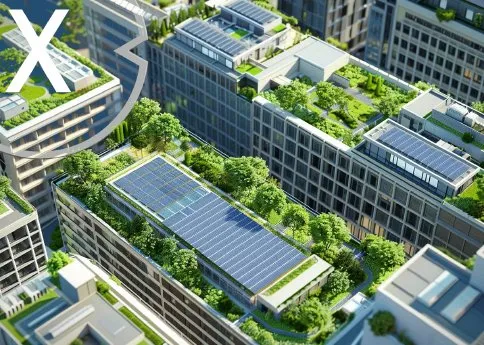Introduction
Manhattan’s skyline is undergoing an eco-revival, as developers integrate green roofs, solar facades, and sustainable design elements into high-rise buildings. These initiatives reflect a growing emphasis on environmental responsibility, energy efficiency, and urban resilience. Eco-conscious architecture not only reduces carbon footprints but also enhances building performance, property value, and livability, positioning Manhattan as a global leader in sustainable urban development.
Drivers of the Eco-Revival
Several factors fuel the adoption of green roofs and solar facades in Manhattan:
-
Environmental Regulations: City policies and incentives promote energy-efficient construction and renewable energy integration.
-
Investor and Tenant Demand: Tenants and buyers increasingly prioritize sustainable living and corporate responsibility.
-
Cost Savings: Renewable energy generation and improved insulation reduce operational expenses over time.
-
Urban Heat Island Mitigation: Green roofs help lower city temperatures, improving air quality and urban comfort.
These factors create a favorable environment for developers to embrace eco-innovations while aligning with economic and social objectives.
Green Roof Implementation and Benefits
Green roofs involve the installation of vegetation on building rooftops, providing insulation, stormwater management, and biodiversity support. They reduce heat absorption, improve air quality, and contribute to energy savings by lowering cooling costs. Additionally, green spaces enhance aesthetics and provide recreational opportunities for residents and employees. Many Manhattan high-rises now feature rooftop gardens, community terraces, and eco-amenities as integral components of design.
Solar Facades and Energy Generation
Solar facades incorporate photovoltaic panels into building exteriors, generating renewable energy while serving as architectural features. These facades enable buildings to produce electricity, offset operational energy consumption, and contribute to the city’s renewable energy targets. Advanced technologies allow integration into curtain walls, windows, and cladding systems, optimizing energy generation without compromising aesthetics. Solar facades transform urban structures into functional energy producers, supporting sustainability and resilience goals.
Economic and Market Implications
Eco-friendly buildings appeal to investors, tenants, and buyers seeking energy-efficient, sustainable properties. Enhanced marketability, reduced utility costs, and potential tax incentives improve financial performance. Buildings with green roofs and solar facades often command premium valuations due to their environmental benefits and forward-looking design. Developers benefit from long-term cost savings, improved occupancy rates, and brand differentiation, positioning eco-architecture as both a financial and ethical strategy.
Urban Planning and Environmental Impact
Manhattan’s eco-revival contributes to broader urban sustainability goals. Green roofs and solar facades mitigate urban heat islands, reduce stormwater runoff, and enhance air quality. They support biodiversity by providing habitats for birds and pollinators, while contributing to citywide carbon reduction targets. Integrating renewable energy generation into building design reduces reliance on centralized power grids, promoting resilience and energy security in densely populated urban areas.
Technological and Design Innovations
Advances in materials, energy systems, and design techniques enable eco-innovations at scale. Lightweight soil systems, automated irrigation, and durable vegetation allow green roofs on high-rise buildings. Solar panels with high-efficiency conversion rates, integrated in transparent or semi-transparent designs, enhance façade functionality without compromising aesthetics. Smart energy management systems optimize solar output, monitor energy consumption, and ensure seamless integration with building operations.
Challenges and Considerations
Despite benefits, eco-architecture presents challenges. Installation and maintenance of green roofs require specialized expertise and ongoing care. Solar facades necessitate structural reinforcement, electrical integration, and regulatory compliance. Higher upfront costs can deter some developers, though long-term savings and incentives offset initial investments. Careful planning, expert collaboration, and lifecycle assessment ensure sustainable, functional, and economically viable outcomes.
Cultural and Market Perception
Eco-architecture resonates with tenants, buyers, and the broader public, signaling environmental awareness and social responsibility. Buildings with green roofs and solar facades are increasingly featured in media, architecture awards, and urban planning showcases. Cultural fascination with sustainable urban living reinforces demand and establishes eco-design as a hallmark of modern, forward-thinking development in Manhattan.
Strategic Insights for Developers and Investors
For developers, eco-revival projects require integration of sustainability goals, technological innovation, and market strategy. Strategic investment in green roofs and solar facades enhances asset value, occupancy rates, and brand reputation. Investors benefit from long-term operational savings, potential tax incentives, and differentiation in a competitive real estate market. Lifecycle planning, maintenance strategies, and energy performance monitoring ensure financial and environmental returns.
Future Outlook: Manhattan’s Sustainable Skyline
Manhattan’s skyline is likely to see continued growth in eco-friendly high-rises. Integration of green roofs, solar facades, vertical gardens, and smart building technologies will redefine aesthetics, sustainability, and urban resilience. Future projects may incorporate energy storage, water recycling, and advanced climate adaptation systems, creating holistic, sustainable urban environments. Manhattan’s eco-revival serves as a model for other global cities, blending architectural innovation, environmental responsibility, and economic pragmatism.
Conclusion
The integration of green roofs and solar facades demonstrates Manhattan’s leadership in sustainable architecture and urban development. Eco-innovations enhance energy efficiency, environmental performance, and resident experience while reinforcing market competitiveness. As developers, investors, and city planners embrace sustainability, Manhattan’s skyline becomes both a cultural icon and a functional tool for environmental stewardship. The eco-revival represents a convergence of design, technology, and responsibility, reshaping the city for the future.




